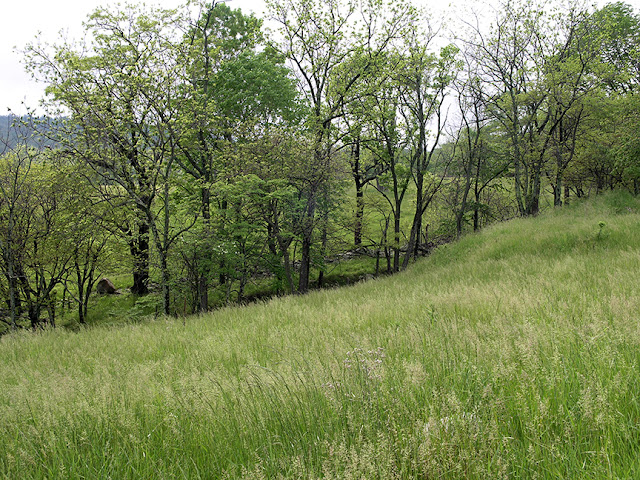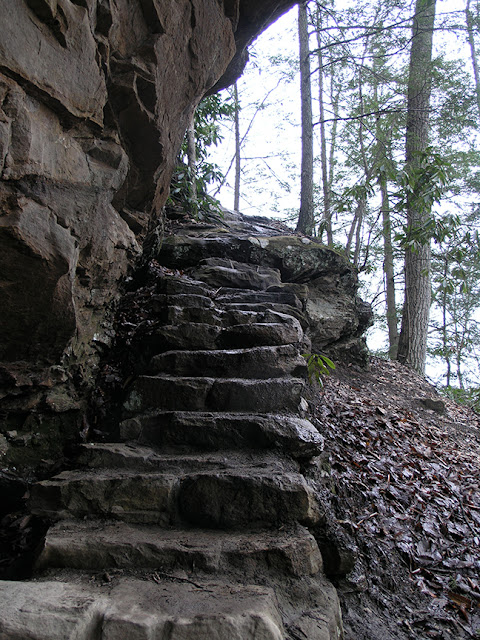 |
| Fragrant Pineseap (Monotropsis odorata). |
I texted my on-line friend, Dr. Matthew Klooster, on Saturday morning to arrange the time we would meet, since Natural Bridge State Park was about an hour's drive from his home. He expected to arrive sometime around 10 AM and I agreed to wait for him in the lobby of the Lodge.
He was running a bit late, but since there weren't many guests at the lodge, we identified each other right away even though it was our first face-to-face meeting. He was a nice looking young man, sporting a fashionably trim beard and we chatted easily at the lodge for a short while before setting out to find the Fragrant Pinesap plants.
Dr. Matt explained that the site was in the Daniel Boone National Forest, about a ten minute drive from the lodge. He drove back towards the main road, but from there I couldn't tell the direction where we headed, nor what turns we made to get to the site. We reached the area and there were a lot of cars parked along the gravel road--apparently this is a popular hiking area, and despite the cloudy, chilly weather, there were lots of hikers here today. We had to circle around to find a suitable place to pull off and park his SUV.
We walked for a few minutes along a trail and as we were passing by a few scrubby young pine trees he looked into the underbrush and exclaimed "Here's some!" I looked but saw nothing there. He walked further into the woods behind some bushes and said, "Here's more, there's lots of them right here."
 |
| Dr. Matt Klooster photographing the Fragrant Pinesap |
I leaned down close to the ground and he pointed to these tiny caps peeking out from the leaf litter--one could barely tell they were plants, much less flowers. I could have walked right on top of them and never known I was upon them! I got down on my knees to see better and started taking photos.
I marveled at how Matt had been able to spot these tiny flowers and he told
me it had taken him some time to learn to see them, but after a
number of years studying them for his dissertation, he had it down perfectly. Interestingly, the plants
here seemed to prefer growing under young pine trees, rather than the
more mature forest I would have expected. I wonder what species of
mycorrhizal fungi they associate with?
 |
| Fragrant Pinesap |
I had a difficult time with my camera's automatic focus--the leaf litter
competed with the inconspicuous flowers so well it couldn't decide where to focus. Fortunately I had my
cell phone with me and Matt suggested I try using that. The phone's camera did the
trick--it was much easier to zoom in and get exactly what I needed. I shot lots of different individuals, more than enough for my
illustrations, in just this one small patch.
The range of color variation from plant to plant is considerable, some of the stems were a deep magenta-purple, with others a much more subdued reddish brown or nearly black. There wasn't much fragrance today, but if you got your nose down very close, a faint aroma of camphor, or maybe clove, could be detected. I figured this had to be due to the cold, since I've heard that many people locate the plant by scent before they can see it.
With such tiny flowers, I wondered what insect pollinated them. Presumably the scent attracted the pollinator. Matt explained that the flowers were buzz-pollinated by bumblebees. Buzz-pollination is accomplished by the bee beating its wings at a certain frequency that causes the pollen to be released from the pollen sacs. How exactly does the bee know to do this is a mystery worth pondering...
After this we walked a bit farther down the trail, where Matt pointed out some crested iris starting to open, and a few other spring flowers. The orange color of the fruiting bodies of some lichens again caught my eye.
 |
| Orange-fruited lichen |
These looked very like the Pink Bubblegum lichen I'd seen on Laurel Ridge the day before, but bright orange in color. It was growing alongside some Trailing Arbutus, just as on the ridge.
My friend Matt had to get back to his family soon, so shortly after this, we walked back to his car and he dropped me off at Hemlock Lodge. A brief, but amazing encounter with a fascinating gentleman and botanical subject! I had more than enough material to keep me busy painting for a good long time.
I started the painting several months later, recently. Here's a photo of my painting in progress (not very well-lit).
 |
| Monotropsis watercolor in progress. |
















































